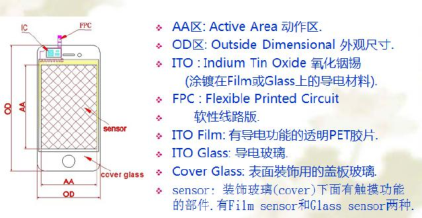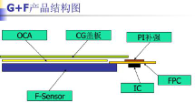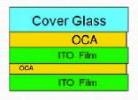How CTP works?
CTP–Projected Capacitive Touch Screen
Construction: Using one or more etched ITO templates to form a scan line array having different planes while being perpendicular to each other, the transparent wires form a x, y-axis drive induction line.
How it works: When a finger or a specific medium touches the screen, the pulse current is driven by the drive line.The scanning wire is simultaneously received to receive the sensing line signal of the touch position pulse frequency in the vertical direction due to the significant change of the capacitance value, and the control chip polls the detection capacitance value change data to the main controller according to the set frequency, and confirms the touch after the data conversion calculation Point location.
Basic composition of CTP
The CTP is mainly composed of the following parts:
—Cover Lens: Protects the CTP module. When the finger touches, it forms a certain relationship with the sensor.
The distance to allow the fingers of the hand to form a capacitor with the sensor.
—Sensor: Receive the pulse signal from the control IC to form an RC network on the entire plane.
A capacitor is formed when the finger is close.
—FPC: Connect the Sensor to the Control IC and connect the Control IC to the host.

Common capacitive screen classification:
1.G+G (Cover Glass+Glass Sensor)
• Features: This structure uses a layer of Glass Sensor, the ITO pattern is generally diamond-shaped, supporting true multi-point.
• Advantages: optical adhesive bonding, high light transmittance (about 90%), suitable for outdoor use, Sensor for glass
Quality, not easy to be affected by temperature, stable performance, and mature technology.
• Disadvantages: The cost of mold opening is high, and the Glass Sensor is easily damaged by impact and the overall thickness is thick.
• The process is complex and costly, suitable for industrial, automotive and other fields.
• Support up to 10 touches.

2.G+F (Cover Glass+Film Sensor)
• This structure uses a single-layer Film Sensor. The ITO pattern is generally triangular and supports gestures, but does not support multiple points.
• Advantages: low cost, short production time, good light transmission (about 90%), and the total thickness of the sensor is thin, conventional
The thickness is 0.95mm.
• Disadvantages: Based on a single point, multi-touch is not possible and the anti-interference ability is poor.
• Sensor glass uses Film, commonly known as film, which is a soft film that is easy to fit, so the cost is low, generally
Only single touch plus gestures are supported. Relative to the Glass material, he will have a shadow when the temperature changes.
The ringing will be bigger. This material was widely used in consumer electronics such as mobile phones and tablet computers in China.

3.G+F+F(Cover Glass+Film Sensor+Film Sensor):
• Features: This structure uses two layers of Film Sensor. The ITO pattern is generally diamond-shaped and rectangular, supporting true multi-point.
• Advantages: high accuracy, good handwriting, support for real multi-point; Sensor can do profile, mold cost
Low, short time, thin total thickness, regular thickness of 1.15mm, strong anti-interference ability.
• Disadvantages: The light transmittance is not as high as G+G. At around 86%.

4.G+F+F (PET+Glass Sensor)
• The surface of the P+G capacitive screen is PET plastic. The hardness is usually only 2~3H, which is quite soft. It is very easy to make everyday.
Scratches must be applied and carefully protected. The advantages are simple process and low cost.
• The surface of the P+G capacitive screen is plastic, which is easy to harden and change under the action of acid, alkali, oily substances and sunlight.
It is brittle and discolored, so it must be used with care to avoid contact with such substances. If used improperly, it will also produce aerosols and
White spots, very difficult to serve.
• P+G’s PET cover has a light transmittance of only 83%, and the light loss is severe, and the picture is inevitably low and dull.
The passage of time The transmittance of the PET cover is gradually reduced, which is a fatal flaw in the G+P capacitive screen.
• P+G’s PET plastic is a kind of polymer material with a large surface resistance, and the hand feels slippery and not smooth.
Very affects the operating experience. P+G capacitive screen is made of PET with chemical glue, the process is very simple, but
Bonding reliability is not high. Another important point: sensor tempered glass and PET plastic cover for G+P capacitive screen
The expansion coefficient of the thermal expansion and contraction of the plate is greatly different. At high temperature or low temperature, the G+P capacitive screen will accommodate
It is easy to crack because of the difference in expansion coefficient, so it is scrapped! So the G+P capacitive screen will have a better repair rate than the G+G capacitor.
The screen is much higher.
5. OGS
Touch panel manufacturers will integrate Touch Sensor and Cover Glass
